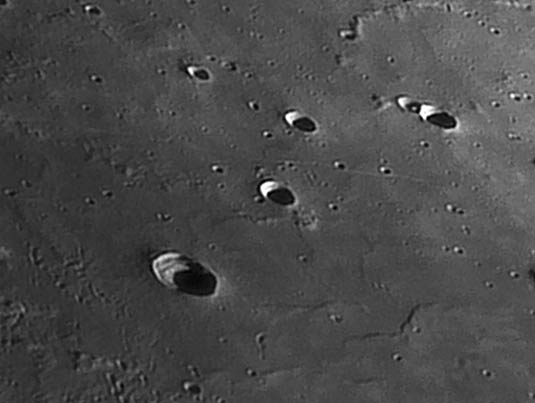Difference between revisions of "February 13, 2005"
| Line 23: | Line 23: | ||
<table class="story" border="0" bgcolor="#FFFFFF" width="90%" cellpadding="10" align="center"><tr><td> | <table class="story" border="0" bgcolor="#FFFFFF" width="90%" cellpadding="10" align="center"><tr><td> | ||
<p align="center"><b>Nearly Invisible Rille</b></p> | <p align="center"><b>Nearly Invisible Rille</b></p> | ||
| − | <p align="left">Rilles are detectable when their narrow walls either cast a shadow or brightly reflect a high Sun. Rilles that run east-west are difficult to image because their walls are mostly not at right angles to the Sun’s illumination. That is the case with the Sheepshanks Rille seen here. There is not a lot to see of the rille even with Lunar Orbiter IV. It is narrow and runs relatively straight for about 200 km. It is apparently a graben – the type of rille that is usually radial or concentric to a basin edge, but the Sheepshanks Rille is neither. It might be roughly radial to Garguantuan/Procellarum, but that speculative superbasin is not well defined in this area of the Moon. Lunar linear graben probably are the surface expressions of intruded dikes (vertical sheets of magma) that fill extensional weak zones radial to basins. Often the graben have associated volcanic features but there is little evidence for such here. The mouseover shows that there may be two different ages to Mare Frigoris in this region. Galle sits in a part that has relatively few impact craters, and thus must be younger than the region north of the white line that contains the rille. The craters near Galle and Galle A are secondaries from [ | + | <p align="left">Rilles are detectable when their narrow walls either cast a shadow or brightly reflect a high Sun. Rilles that run east-west are difficult to image because their walls are mostly not at right angles to the Sun’s illumination. That is the case with the Sheepshanks Rille seen here. There is not a lot to see of the rille even with Lunar Orbiter IV. It is narrow and runs relatively straight for about 200 km. It is apparently a graben – the type of rille that is usually radial or concentric to a basin edge, but the Sheepshanks Rille is neither. It might be roughly radial to Garguantuan/Procellarum, but that speculative superbasin is not well defined in this area of the Moon. Lunar linear graben probably are the surface expressions of intruded dikes (vertical sheets of magma) that fill extensional weak zones radial to basins. Often the graben have associated volcanic features but there is little evidence for such here. The mouseover shows that there may be two different ages to Mare Frigoris in this region. Galle sits in a part that has relatively few impact craters, and thus must be younger than the region north of the white line that contains the rille. The craters near Galle and Galle A are secondaries from [[February_6,_2005| Aristoteles.]] </p> |
<blockquote><p align="right">— [mailto:tychocrater@yahoo.com Chuck Wood]</blockquote> | <blockquote><p align="right">— [mailto:tychocrater@yahoo.com Chuck Wood]</blockquote> | ||
<p align="left"><p><b>Technical Details:</b><br> | <p align="left"><p><b>Technical Details:</b><br> | ||
Revision as of 14:39, 17 January 2015
Nearly Invisible Rille
<nobr>Nearly Invisible Rille</nobr> |
Image Credit: Paolo R. Lazzarotti
|
|
Nearly Invisible Rille Rilles are detectable when their narrow walls either cast a shadow or brightly reflect a high Sun. Rilles that run east-west are difficult to image because their walls are mostly not at right angles to the Sun’s illumination. That is the case with the Sheepshanks Rille seen here. There is not a lot to see of the rille even with Lunar Orbiter IV. It is narrow and runs relatively straight for about 200 km. It is apparently a graben – the type of rille that is usually radial or concentric to a basin edge, but the Sheepshanks Rille is neither. It might be roughly radial to Garguantuan/Procellarum, but that speculative superbasin is not well defined in this area of the Moon. Lunar linear graben probably are the surface expressions of intruded dikes (vertical sheets of magma) that fill extensional weak zones radial to basins. Often the graben have associated volcanic features but there is little evidence for such here. The mouseover shows that there may be two different ages to Mare Frigoris in this region. Galle sits in a part that has relatively few impact craters, and thus must be younger than the region north of the white line that contains the rille. The craters near Galle and Galle A are secondaries from Aristoteles. Technical Details: Related Links: Tomorrow's LPOD: Mare Swells |
|
Author & Editor: Technical Consultant: Contact Translator: A service of: |
COMMENTS?
Register, and click on the Discussion tab at the top of the page.




